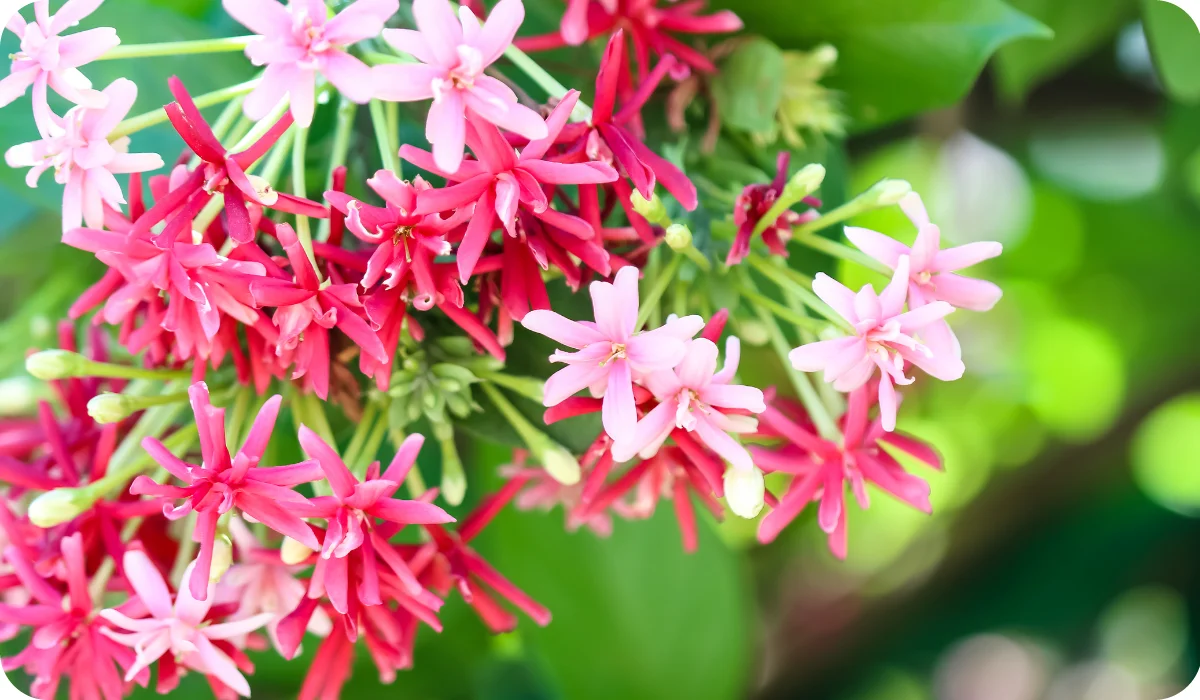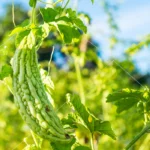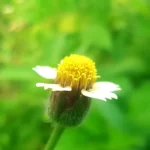Madhumalti Flower / Madhumalati – Benefits of Rangoon Creeper Plant
Hindi – मधुमालती
Madhumalti, also known as the Rangoon Creeper plant, is a beautiful flowering plant that holds a special place in Indian culture. Its Hindi name ‘Madhumalti’, which means ‘sweet jasmine’, perfectly describes its sweetly scented flowers that bloom in a mesmerizing array of colours.
In this article, we will explore the many facets of the Madhumalti plant, its benefits, and how to grow and care for it. We will also discuss where you can buy online these beautiful plants for your home garden.

Understanding the Madhumalti Plant (Combretum Indicum)
Madhumalti Flower: A Spectacular Bloom
The Madhumalti plant is renowned for its stunning flowers that bloom in a spectacular display of changing colours. The flower buds open to reveal pristine white petals that gradually transform into pink and finally a deep, romantic red. This enchanting colour play is a visual treat and a testament to the unmatched beauty of nature.
The Madhumalti flower has a sweet fragrance that fills the air, creating an atmosphere of calm and relaxation. It’s a delightful sensory experience that makes the Madhumalti plant a favourite among gardeners and homeowners.
Madhumalti: A Versatile Vine
Scientifically known as Combretum Indicum, the Madhumalti plant is a versatile vine that can easily adapt to various environmental conditions. It can grow in a range of soil types and pH levels, from slightly acidic to slightly alkaline.
The Madhumalti plant is a hardy species that can withstand different climates, making it a great choice for outdoor gardens. However, it thrives best in warm and humid conditions, typical of its native tropical Asian regions.
Madhumalati: A Friend to Wildlife
The Madhumalati plant plays an important role in the ecosystem as it attracts a variety of wildlife, including birds and butterflies. The sweet nectar of the Madhumalti flower is a favourite among these creatures, making the plant a vital source of food in the wild.
Grow and Care of Rangoon Creeper
Growing the Madhumalti or Rangoon creeper plant in your home garden is a rewarding experience. Not only does it enhance the aesthetic appeal of your garden, but it also brings a sense of tranquillity with its sweet fragrance. Here’s a comprehensive guide on how to grow and care for this beautiful plant.

Propagation using Cuttings: The First Step
Propagation of the Rangoon creeper or Madhumalti plant is usually done through stem cuttings. Choose a healthy stem, about 6-8 inches long, and make a clean cut just below a node. Remove any leaves from the lower part of the cutting and insert it into a well-draining potting mix.
Planting the Madhumalti
Once the cutting has developed roots, it’s time to plant it in your garden. Choose a sunny spot with well-draining soil for your Madhumalti plant. Dig a hole twice the size of the root ball, place the plant inside, and backfill with soil.
Water the plant thoroughly after planting to help it establish in its new home.
Care of Rangoon Creeper: Ensuring Healthy Growth

Caring for the Rangoon creeper involves regular watering, fertilizing, and pruning.
Watering
The Madhumalti plant prefers a moist but not waterlogged soil. Water the plant when the top inch of soil feels dry to the touch.
Fertilizing
To ensure healthy growth and abundant flowering, apply a balanced fertilizer every 2-3 months during the growing season.
Pruning
Regular pruning helps maintain the shape and size of the Madhumalti plant. It promotes more compact and bushy growth and encourages more abundant flowering.
Madhumalti Plant Benefits – Why Grow the Rangoon Creeper
The benefits of Rangoon creeper or Madhumalti plant extend beyond its ornamental value. Here are some reasons why you should consider adding this plant to your garden.
Grow Madhumalti for an Aesthetic Appeal
The vibrant flowers and lush green foliage of the Madhumalti plant enhance the overall beauty of your garden. Its cascading vines create an enchanting display that can transform any space into a tropical paradise.

Health Benefits of Rangoon Creeper or Madhumalti and Why Grow it in Home Gardens
Rangoon Creeper, also known as Madhumalti or Madhumati, is a popular ornamental plant with a divine fragrance and stunning flowers. Its captivating beauty and delightful fragrance make it a valuable addition to home gardens. However, beyond its aesthetic appeal, Rangoon Creeper’s potential health benefits linked to its leaves have been noted in traditional medicine. These benefits and why you should consider growing this plant in your home garden are explored further below.
Potential Health Benefits
The leaves of the Rangoon Creeper, commonly referred to as Madhumalti or Malati, have therapeutic properties and have been used to treat various health conditions.
- Anti-inflammatory properties: In traditional medicine, these leaves have been utilized to alleviate inflammation-related health conditions, making them potentially useful in managing various inflammatory disorders.
- Diabetes management: While scientific research is limited, anecdotal evidence suggests the leaves may have a positive impact on blood sugar levels. However, individuals with diabetes should consult their healthcare provider before incorporating Rangoon Creeper leaves into their treatment plan.
- Skin health: The leaves have been used topically to alleviate skin conditions such as rashes, itching, and inflammation. Their anti-inflammatory and soothing properties may help provide relief and promote skin health. However, always consult a dermatologist or healthcare professional before using any plant-based remedies on the skin.
- Other uses: The juice extracted from the leaves is effective in settling boils and abscesses. Additionally, applying the leaves on the forehead can help reduce headaches. Boiling the leaves to make a tea can provide relief from dysuria or painful urination.
Other Parts of the Plant
Beyond the leaves, other parts of the Rangoon Creeper also offer potential health benefits.
- Dried Seeds: The dried seeds of Rangoon Creeper are beneficial in treating intestinal worms and parasites.
- Fruits: The ripe and roasted fruits of Rangoon Creeper can be used to treat diarrhea and fever. They are also helpful in reducing inflammation of the kidneys and treating conditions like nephritis.
Why Grow Rangoon Creeper in Home Gardens
In addition to these health benefits, growing Rangoon Creeper in home gardens offers several advantages. The leaves of Rangoon Creeper do not drop easily, contributing to the plant’s year-round visual appeal. Unlike some other plants that shed their leaves seasonally, Rangoon Creeper retains its foliage, providing a lush and vibrant appearance throughout the year.
By cultivating Rangoon Creeper in your home garden, you can enjoy the aesthetic beauty of its flowers, the pleasant fragrance it emits, and the potential health benefits associated with its leaves. However, it is important to note that while Rangoon Creeper has a long history of traditional use, scientific research on its medicinal properties is limited. Therefore, always consult with healthcare professionals or experts in herbal medicine before using Rangoon Creeper or any other plant for medicinal purposes.
Attracting Wildlife
As mentioned earlier, the Madhumalti plant is a magnet for birds and butterflies. By adding this plant to your garden, you can enjoy the delightful sight of these creatures fluttering around your garden.
Uses of Madhumalti Plant (Combretum Indicum)
The uses of Madhumalti are diverse, ranging from its role in traditional medicine to its value as an ornamental plant. In addition to this, the Madhumalti plant has been used in various cultural practices and ceremonies, reflecting its significant place in Indian culture.

Madhumalti in Traditional Medicine
The leaves of the Madhumalti plant have been used in traditional medicine for centuries. They are believed to have anti-inflammatory properties and are used to treat a wide range of health conditions. However, it’s essential to consult a healthcare professional before using any plant for medicinal purposes.
Madhumalti as an Ornamental Plant
The breathtaking beauty and sweet fragrance of the Madhumalti flower make it a popular choice for home gardens. It’s a versatile plant that can be grown on trellises, fences, or as a stand-alone shrub, making it a great addition to any landscape.
Buy Online: Bringing Madhumalti Home
If you’re ready to experience the charm of the Madhumalti plant, you can buy online from various gardening websites. They offer a wide range of options, from young plants ready for planting to mature plants that can instantly transform your garden.
Getting a Madhumalti plant for your home garden is a decision you won’t regret. Its beautiful flowers, sweet fragrance, and easy care make it a favourite among gardeners. So why wait? Start your gardening adventure with the Madhumalti plant today!
FAQs People Also Ask about Madhu Malti (With Straight Answers)
Q: How can I grow Rangoon creeper or madhumalti successfully?
A: The madhumalti plant is easy to grow. It is a tropical plant that does well in partial shade. The plant needs support for growing so it is advisable to use a tree or a stake. For propagation, insert the cutting into the soil and make sure it is watered regularly. The madhumalti plant needs regular watering and doesn’t need much care otherwise. Be sure to prune the plant to maintain its shape and encourage blooming.
Q: What care does the madhumalti plant require?
A: Madhumalti or Rangoon creeper plant care is minimal. The plant needs regular watering, to be kept in partial shade and to be pruned occasionally. The plant needs support for growing, like a tree or a stake. It is a fairly easy to grow plant which does not need much care.
Q: I want to buy Rangoon creeper plant online. What should I know?
A: Buying plants online can sometimes be tricky. Make sure you are purchasing from a reputable source. The Rangoon creeper is known as madhumalti in English, also known as Chinese Honeysuckle, Madhabilata, and Madhumalti Bel. Ensure that the plant is in good health upon arrival. This plant is ideal for homes as an ornamental plant.
Q: How do I propagate the rangoon creeper’s plant?
A: Propagation of the Rangoon creeper plant is usually done by cutting. Follow these steps: take a healthy branch, insert the cutting into the soil and water regularly. The plant is easy to grow and doesn’t need much care. It can take a few weeks for the roots to develop.
Q: What are the uses of madhumalti besides its conspicuous charm?
A: Madhumalti is known for its medicinal and therapeutic benefits. The leaves are used in different remedies and the plant has many uses apart from being an ornamental plant. The madhumalti plant is used for its fragrant flowers and its ability to attract pollinators.
Q: How should I prune the madhumalti or rangoon creeper?
A: Prune the plant after it has finished blooming. Cut off any dead or diseased wood. This will help to encourage the plant to produce more flowers. Regular pruning helps keep the plant in shape and promotes blooming. Keep the plant in partial shade to ensure it continues blooming.
Q: What distinguishes the chinese honeysuckle from the rangoon creeper?
A: Both the Chinese honeysuckle and the Rangoon Creeper are from the same family. The main distinguishing feature is the flower color. Rangoon Creeper has a fragrant, tubular flower that changes color from white to red. The Chinese honeysuckle usually has yellow or white flowers. Both are tropical plants and easy to grow.
Q: Can the madhumalti thrive as an indoor plant?
A: Yes, the Madhumalti or Rangoon Creeper can grow as an indoor plant. The plant needs good exposure to light, so keep it near a window that has bright indirect sunlight. It also thrives in partial shade and should be watered regularly. Note that the madhumalti plant needs support for growing, so it is advisable to use a stake.
Q: How frequent are the blooming periods of the madhumalti plant?
A: The madhumalti or Rangoon creeper plant produces fragrant flowers that change color from white to pink to red. The plant blooms mostly throughout the summer and the monsoon season. The flowering splendor of the Rangoon Creeper is a great addition to any home garden.
Q: What are the differences between the madhumalti bel and the dwarf rangoon creeper?
A: The madhumalti bel and the dwarf Rangoon Creeper are both types of combretum indicum plants. The dwarf Rangoon creeper is a smaller version of the plant, and is such more suitable for indoor use or for homes with smaller garden space. Both types share the fragrant, colorful flowers characteristic of this plant species.
About our Web Store www.shehrikisaan.com
For a wide selection of fertilizers and soil amendments suitable for all these plants, we invite you to explore our esteemed webstore at www.shehrikisaan.com. Our webstore offers a comprehensive range of products designed to enhance the growth and vitality of your plants.
Whether you’re seeking specialized fertilizers, organic amendments, or premium-quality soil enhancers, our webstore is your one-stop destination. With our commitment to providing garden enthusiasts with top-notch products, you can trust us to cater to your gardening needs effectively. Visit www.shehrikisaan.com today and unlock the secret to flourishing plants.
Discover our Social Media Presence and web store. Choose your favourite platforms:
















